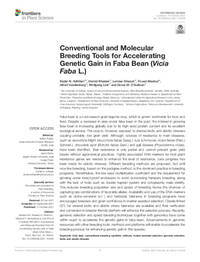Conventional and Molecular Breeding Tools for Accelerating Genetic Gain in Faba Bean (Vicia Faba L.)

Authors:
Faba bean is a cool-season grain legume crop, which is grown worldwide for food and feed. Despite a decrease in area under faba bean in the past, the interest in growing faba bean is increasing globally due to its high seed protein content and its excellent ecological service. The crop is, however, exposed to diverse biotic and abiotic stresses causing unstable, low grain yield. Although, sources of resistance to main diseases, such as ascochyta blight (Ascochyta fabae Speg.), rust (Uromyces viciae-fabae (Pers.) Schroet.), chocolate spot (Botrytis fabae Sard.) and gall disease (Physioderma viciae), have been identified, their resistance is only partial and cannot prevent grain yield losses without agronomical practices. Tightly associated DNA markers for host plant resistance genes are needed to enhance the level of resistance. Less progress has been made for abiotic stresses. Different breeding methods are proposed, but until now line breeding, based on the pedigree method, is the dominant practice in breeding programs. Nonetheless, the low seed multiplication coefficient and the requirement for growing under insect-proof enclosures to avoid outcrossing hampers breeding, along with the lack of tools such as double haploid system and cytoplasmic male sterility. This reduces breeding population size and speed of breeding hence the chances of capturing rare combinations of favorable alleles. Availability and use of the DNA markers such as vicine-convicine (vc−) and herbicide tolerance in breeding programs have encouraged breeders and given confidence in marker assisted selection. Closely linked QTL for several biotic and abiotic stress tolerance are available and their verification and conversion in breeder friendly platform will enhance the selection process. Recently, genomic selection and speed breeding techniques together with genomics have come within reach to accelerate the genetic gains in faba bean. Advancements in genomic resources with other breeding tools, methods and platforms will enable to accelerate the breeding process for enhancing genetic gain in this species.
